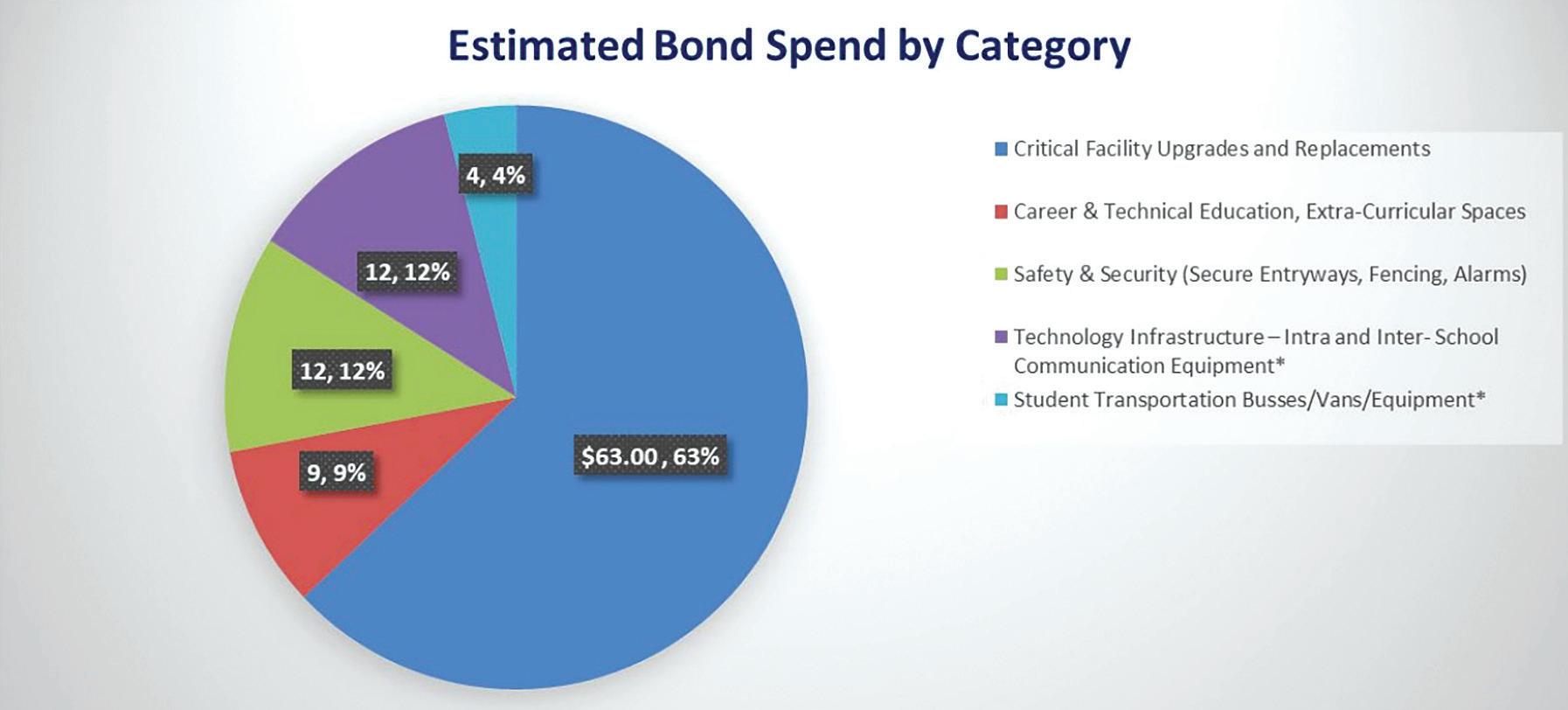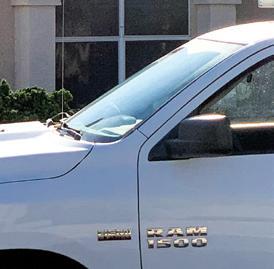


Several






Several


Gilbert O cer Levi Leyba remembered responding to a call where a grandmother reported that her grandson was missing.
e boy, 11 or 12 years old, lived with his grandparents and often rode his bicycle around the development. He also was autistic.
Competitive pay and critical facility maintenance are some of the proposed expenditures for a 15% budget override and a $100-million bond going to Gilbert Public Schools voters this November in an all-mail election.
e Governing Board last week voted 5-0 for placing a continuance of an existing override and 4-1 for a general obligation
“So the child usually gets home if he’s out with a friend at 8, 9:30 p.m.,” Leyba said. “He had not come home. She got concerned.”
Leyba interviewed the grandmother, friends in the neighborhood and made sure the house was cleared because “kids like to hide,” while other o cers searched the area, checking out places the boy liked to go to. en Leyba’s recently acquired autism awareness training kicked in.
Children with autism spectrum disorder
or ASD tend to wander and “a lot like to go to the park and bodies of water,” said Leyba, now a spokesman for the department.
Leyba recalled nding the boy in a park area by water in south Gilbert. He would not disclose the park.
“He was walking his bike when I came across him,” Leyba said. “I called out his name and he looked at me.

While Higley Unified, Gilbert Public Schools and most other districts in the East Valley will be sending off their Class of 2023 this week, the East Valley Institute of Technology bid adieu to its seniors last week. The class of 2,500 seniors from scores of high schools who attended EVIT in half-day sessions the last two years was so large the ceremonies were split across two days so that Sloan Park stadium in Mesa could accompany the newly minted grads and their guests comfortably. EVIT Superintendent Dr. Chad Wilson offers some insight into this year’s graduates in a special report on page 8. (David Minton/GSN Staff Photographer)
















CONTACT INFORMATION
Main number: 480-898-6500 | Advertising: 480-898-6559
Circulation service: 480-898-5641
Publisher: Steve T. Strickbine
Vice President: Michael Hiatt
ADVERTISING DEPARTMENT
Display Advertising: 480-898-6309
Classifieds/Inside Sales:
480-898-6500 | classi eds@timeslocalmedia.com TJ Higgins | 480-898-5902 tjhiggins@timeslocalmedia.com Steve Insalaco |480-898-5635 sinsalaco@timeslocalmedia.com
Advertising Sales Executive: Jane Meyer | 480-898-5633 jane@timeslocalmedia.com
NEWS DEPARTMENT
Executive Editor: Paul Maryniak | 480-898-5647 pmaryniak@timeslocalmedia.com
Managing Editor: Cecilia Chan | 480-898-5613 cchan@timeslocalmedia.com
Reporters: Ken Sain | 928-420-5341 ksain@timeslocalmedia.com
Get Out Editor:
Christina Fuoco-Karasinski | 480-898-5631 christina@timeslocalmedia.com
Sports Editor: Zach Alvira | 480-898-5630 zalvira@timeslocalmedia.com
Photographer:
Dave Minton | dminton@timeslocalmedia.com
Design:
Veronica Thurman | vthurman@timeslocalmedia.com
Design/Production Supervisor Courtney Oldham | production@timeslocalmedia.com
Circulation Director:
Aaron Kolodny | aaron@phoenix.org
BY CECILIA CHAN GSN Managing EditorAnon-denominational church has purchased the site it sits on and two nearby commercial buildings at the 166-acre Gilbert Town Square for $24 million.
e 11.21 acres comprises the 31,852-square-foot Christ Church Gilbert, a 45,110-square-foot building housing the 14-screen Regal eater and a 37,647-square foot building with retail, including an indoor in atable play center, an autism treatment provider, an escape room, piano store and a dental o ce, according to Valley real estate tracker vizzda.com.
Christ Church, with three locations in the Valley, borrowed $19 million from Wesleyan Investment Foundation and raised $4.9 million for the down payment, according to vizzda.
Wesleyan referred calls about the May 10 sale to Je rey Carlson, the church’s senior executive pastor.
It was unknown the church’s intention for the property as Carlson could not be reach for comment. e broker and the seller BH Properties also did not respond.
For now, it appears to be status quo for the existing tenants.
Alysen Lukacik, an owner of International Room Escape AZ, said she was noti ed of the new ownership via email from the church.
She said the property sale was “a surprise for everybody.”
at said, she added, “We are allowed to stay here until the end of our lease and then we will see what happens.”
e business has two more years on its lease.
“I know those guys over there, they are good guys,” said Josh Wallace, owner of My First Piano. “I’m not sure what their plans are for the plaza. When our lease is

up next year we’ll look for an opportunity to maybe build or move somewhere else.”
Wallace said that was the intention even before the church purchased the building as My Piano has been at its current location since 2015 and is “ready to move,” he added.
Congregants and the senior lead pastor at the Gilbert campus rejoiced on social media after the deal closed.
“It’s been an historic day for our church…11.5 acres and 100k+ square feet of space will be home to Christ Church permanently,” wrote the Rev. Adam Bailie, who also did not respond to a request for comment.
“May every single generation be made, matured, and mobilized as disciples on this property until our Christ returns!”
A woman posted, “So exciting. We are so grateful for our church and the growth we are in.”
One man commented “Can we keep the movie theater?” while another said, “I’m wondering if we can keep the recliners for service.”
BH Properties in December 2013 purchased eight buildings at the shopping center, including the ones that sold earlier this month, a total of 159,000 square feet of
retail for $13.4 million.
Gilbert Town Square was built in several stages beginning in 2001 and is home to a 44-lane bowling alley, a brewing place and several eateries such as Sal’s Gilbert Pizza. e shopping center is across Gilbert Road from the Town’s municipal complex.
Gilbert Town Square also includes a residential component, the 24-building Town Commons built in 2018, which includes town houses, carriage homes and apartments.
Christ Church incorporated as a domestic nonpro t corporation in 2012 with the Arizona Corporation Commission. e Gilbert church opened in 2012, followed by locations in Peoria and Central Phoenix.
Besides ministering to the congregation, the church provides other services such as City Hope and Vintage Mission. City Hope, with locations in Chandler and Phoenix, provides food, hygiene products and clothing for free to those in need.
According to Vintage Mission, a nonpro t incorporated in 2018, its goal is to help churches ourish and multiply. Bailie is listed as the president and Carlson the CEO.




















“‘Your grandmother is concerned’ and it went from there. He was slow in responding.”
It’s like someone who is not a native English speaker who has to process what is being said back into his or her language, Leyba explained.
“You have to speak directly and in short phases and allow for delay responses,” he said. “You got to wait and repeat or rephrase it.
“Lot of times they talk to themselves and not give you eye contact. It doesn’t necessarily mean they are avoiding us, it’s just how they are.”
Also, many of those with ASD don’t understand simple slang – “are you pulling my leg: can become literal for them, according to Leyba.
And there are those who are non-verbal. That is when a notebook and pen that cops carry come in handy, he added.
“So after some time we were able to figure out he was ready to go home,” Leyba said. “We put his bike in the back seat in the patrol car and he was reunited.”
Gilbert Police Department is part of a growing trend of rst responders trained on how to interact with people with autism. Locally Queen Creek Police and Fire departments and the cities of Mesa and Tempe have all earned their Certied Autism Center designations.
e International Board of Credentialing and Continuing Education Standards awarded Gilbert Police a Certi ed Autism Center designation last spring and Gilbert Fire and Rescue Department Becomes received its certi cate in April. Gilbert Parks and Recreation also is certi ed.
According to IBCCES, its law-enforcement program covers topics such as common signs or behaviors that someone may be autistic, empathy and understanding, sensory sensitivities, communication tips and safety concerns such as running or wandering away and drowning.
IBCCES is the only credentialing organization providing this type of certification.
e Centers for Disease Control and

Prevention reported in March that about 1 in 36 children are identi ed with ASD – up from the 1 in 44 in 2018. Boys are diagnosed with the developmental disability nearly four times more than girls.
ose with ASD often have problems with social communication and interaction. Other signs of ASD include avoiding eye contact, repeating words or phases, giving unrelated answers to questions, hand apping, body rocking and having unusual reactions to sound, smell and feel.
Leyba said in order to receive the certi cate, 80% of the department’s personnel who have direct contact with public – dispatchers and patrol o cers –had to take the training. e annual training is two hours online.
Leyba said concerns from the community prompted the department to look at the training.
“We get confronted with people asking simple questions – ‘my daughter is 14 years old and looks like an adult,’” he said. “ ey show a genuine concern for the welfare of their children. We thought it would be great for us to go through this training.”
According to the National Institute of Health, about 20% of youth with autism has been stopped and questioned by police by age 21 and nearly 5% arrested. Without autism awareness training, those encounters could turn dangerous.
A case in point involved a 14-year-old autistic boy in 2017 who was “stimming”
with a piece of string – a self-soothing behavior common in children with ASD –while standing alone in a park in Buckeye. Cops, however, mistaken the boy to be using an illegal inhalant drug.
While o cers were questioning the boy, he attempted to walk away. On the second attempt, an o cer grabbed the boy’s arm to handcu him and both fell to the ground leading to various injuries, including an ankle injury that required
“Lot of adults and lot of children are being diagnosed with autism and on the spectrum scale. It’s important for the department as a whole to go through the training to make sure we were actually helping out the best way in the community.”
surgery, according to a lawsuit led in 2021 against the city and the o cers.
Leyba also pointed to three facilities in town that serve those with autism –Laurens Institute for Education, Autism Academy for Education and Development, and Hopebridge Autism erapy Centers.
“Lot of adults and lot of children are
being diagnosed with autism and on the spectrum scale,” he said. “It’s important for the department as a whole to go through the training to make sure we were actually helping out the best way in the community.”
A resource the department offers and is making a big push to alert the community of is the “Bring Me Home Program.”
It’s a database containing details such as contact information for the department should a family member who is unable to adequately communicate wander away from home. Wandering is common among those with ASD.
e database, a free service to residents, also is intended to help seniors with dementia or Alzheimer’s, those with hearing impairments and those who are developmentally disabled.
To date, 167 people are register in the program, Leyba said.
Although the certi cation has been in place for a year, there are no stats at this time to see how often Gilbert o cers or dispatchers have come into contact with someone with ASD and the e ectiveness of that training, according to Leyba.
“ ere is really no way of knowing,” he said. “Community feedback is the main way we know it’s working.
“There was a need in the community and the positive feedback kind of confirmed we are going in the right direction.”














This week, nearly 2,500 high school students and adults from across the Valley completed career training programs through the East Valley Institute of Technology.
During two ceremonies at Chicago Cubs Sloan Park Stadium, we celebrated these students who will go on to be our next generation workforce.
For our high school students, this was no small feat. Most of them have attended EVIT for a half-day for two years, many of them giving up sports and other activities so they could commit themselves to their career training.
For many of our adult students, this marks the end of a period in which they juggled full-time jobs and families with career training so they could upgrade their skills, earn advanced certi cations or start a new career.
For all of them, this is the beginning of

a journey to see where their EVIT training will take them.
At EVIT, we strive every day to change lives. at’s what quality career training can do. e skills and knowledge our students learn now lay the groundwork for them to have a better quality of life.
It also improves the quality of Arizona’s workforce – which improves the quality of
life for all of us.
We are undergoing a lot of changes at EVIT as we work toward ensuring that the training we provide continues to change lives and meets the evolving needs of our state and workforce.
at’s why we pursued and succeeded in getting legislation passed to allow Career Technical Education Districts like EVIT to o er associate degrees.
When EVIT rst opened its doors 30 years ago, there were many good jobs and careers that did not require any post-secondary education.
But today, the Center for the Future of Arizona estimates that 65% of all jobs require some education and training beyond high school. To help meet that demand, we hope to be o ering at EVIT associate degrees in nursing, paramedics, and surgical technology by January.
In a fast-changing world, our most vulnerable populations often get left behind. At EVIT, we are putting programs and initiatives in place to help ensure that one of
those populations – Arizona’s foster care youth – don’t get left behind.
In June, we will break ground on a new residential facility at the EVIT Main Campus, where students who are getting ready to age out of the foster system can live and receive support services while taking one of our career training programs.
We hope our foster care e orts will become a model that other CTEDs can use to meet the needs of these students who have no family to support them.
ese are challenging life-changing goals that require commitment and hard work. But if the 2,500 EVIT students who crossed the ceremony stage this week are any indication, they are reachable goals that are worth the e ort.
Dr. Chad Wilson is superintendent of the East Valley Institute of Technology, a Career Technical Education District providing career training for high school students and adults at two central Mesa campuses and in high schools in 11 East Valley school districts. Information: evit.com.

The Chandler Uni ed School District is among the best performing in the state. e man who leads the district is being rewarded for that.
e Governing Board gave Superintendent Frank Narducci a new threeyear contract at its May 10 meeting that makes him among the highest paid school superintendents in the state.
Narducci still had a year left on his rst contract that would have paid him a base salary of $215,000. e new deal pays him an annual salary of $250,000. at contract begins July 1 and expires June 30, 2026.
Salaries of superintendents are not readily available for every district in Arizona. However, among the seven largest districts, only Peoria Public Schools Superintendent Sharon Desmoulin-Kherat earns a higher base salary at $268,636.
All ve members of the Chandler Unied Governing Board were asked by this newspaper in an email why they chose to give Narducci a new deal now.
Only one responded, saying the reporter should ask the others.
“Arizona law allows Governing Boards to renegotiate contracts with superintendents within 15 months before the expiration of the current contract,” the district said in a statement.
“ is allows for continuity of leadership which typically promotes stability of a district and student success.”
Chandler Uni ed fared well in the most recent state Auditor General’s report on school districts. It scored better than statewide averages and peer-district averages in all three state assessment tests (math, English language arts, and science).
CUSD students earn tens of millions of dollars in scholarships each year and are recognized both statewide and nationally.
e district also exceeds the state average in teacher pay. However, CUSD ranks 41st overall in teacher pay in Ari-

zona, and 17th among Maricopa County school districts. CUSD’s average teacher salary is $63,584.
Many with higher teacher pay are much smaller and in very rural communities. Among East Valley districts, Chandler Uni ed ranks third in teacher salaries, behind Tempe Union High School and Mesa Public Schools.
e Auditor General’s report also noted that CUSD ranks below both state and peer averages for administration costs. CUSD spends $801 per student on its administration. e state average is $1,088 and the peer average is $921.
Peer average is how the district ranks among others that are about the same size. Chandler Uni ed is the second largest in Arizona, behind Mesa. Tucson Uni ed is third, about 100 fewer students than Chandler. Tucson spends $1,026 per student for its administration. TUSD Superintendent Gabriel Trujillo earns a base salary of $230,000.
ere are other perks that come with being a school district superintendent. Narducci also gets an auto allowance to cover his expenses. It was $850 per
Mesa, AZ - When it comes to chronic pain and/ or neuropathy, the most common doctor-prescribed treatment is drugs like Gabapentin, Lyrica, Cymbalta, and Neurontin. The problem with anti-depressants or anti-seizure medications like these is that they offer purely symptomatic relief, as opposed to targeting and treating the root of the problem. Worse, these drugs often trigger an onset of uncomfortable, painful, and sometimes harmful side effects.
The only way to effectively treat chronic pain and/or peripheral neuropathy is by targeting the source, which is the result of nerve damage owing to inadequate blood flow to the nerves in the hands and feet. This often causes weakness and numbness.

As displayed in figure 1 above, the nerves are surrounded by diseased, withered blood vessels. A lack of sufficient nutrients means the nerves cannot survive, and thus, slowly die. This leads to those painful and frustrating consequences we were talking about earlier, like weakness, numbness, tingling, balance issues, and perhaps even a burning sensation.
The drugs your doctor might prescribe will temporarily conceal the problems, putting a “BandAid” over a situation that will only continue to deteriorate without further action.
Thankfully, Mesa is the birthplace of a brand new facility that sheds light on this pressing problem of peripheral neuropathy and chronic pain. The company is trailblazing the medical industry by replacing outdated drugs and symptomatic reprieves with an advanced machine that targets the root of the problem at hand.

Effective neuropathy treatment relies on the following three factors:
1. Finding the underlying cause
2. Determining the extent of the nerve damage
(above 95% nerve loss is rarely treatable)
3. The amount of treatment required for the patient’s unique condition
Aspen Medical in Mesa, AZ uses a state-ofthe-art electric cell signaling systems worth $100,000.00. This ground-breaking treatment is engineered to achieve the following, accompanied by advanced diagnostics and a basic skin biopsy to accurately analyze results:
1. Increases blood flow
2. Stimulates and strengthens small fiber nerves
3. Improves brain-based pain
The treatment works by delivering energy to the affected area(s) at varying wavelengths, from low- to middle-frequency signals, while also using Amplitude Modulated (AM) and Frequency Modulated (FM) signaling.
It’s completely painless!
THE GREAT NEWS IS THAT THIS TREATMENT IS COVERED BY MEDICARE, MEDICAID, AND MOST INSURANCES!!
Depending on your coverage, your peripheral neuropathy treatment could cost almost nothing – or be absolutely free.
The number of treatments required varies from patient to patient, and can only be determined following an in-depth neurological and vascular examination. As long as you have less them 95% nerve damage, there is hope!
Aspen Medical begins by analyzing the extent of the nerve damage – a complimentary service for your friends and family. Each exam comprises a detailed sensory evaluation, extensive peripheral vascular testing, and comprehensive analysis of neuropathy findings.
Aspen Medical will be offering this free chronic pain and neuropathy severity evaluation will be available until May 31st, 2023. Call (480) 2743157 to make an appointment.
Due to our very busy office schedule, we are limiting this offer to the first 10 callers. YOU DO NOT HAVE TO SUFFER ANOTHER MINUTE, CALL (480) 274-3157...NOW!!
We are extremely busy, so we are unavailable, please leave a voice message and we will get back to you as soon as possible.
The state has suspended payments to over 100 behavioral health group home and outpatient treatment providers believed to be engaging in Medicaid fraud – including six in Gilbert.
“For years these providers have allegedly defrauded the state of millions of dollars while creating a large-scale humanitarian crisis that disproportionately a ects Arizona’s tribal communities,” Gov. Katie Hobbs said at a May 17 news conference.
“It’s alleged that these providers target the most vulnerable people o ering them the false promise that they will be given food housing and access to treatments at a group living home or rehab facility,” she continued.
“People are then left in these facilities without proper access to health care and treatment services. Instead they’re

allowed and sometimes encouraged to continue using drugs and alcohol.”
Hobbs said often the people are prevented from leaving the facility or contacting relatives while the providers fraudulently bill the Arizona Health Care Cost Containment System, the state’s Medicaid program for additional treatments and other health care services.
Hobbs said the state was still working to assess the scope of people a ected and it may be in the thousands. She was joined by Attorney General Kris Mayes, Salt River Pima-Maricopa Indian Community President Martin Harvier, AHCCCS Director Carmen Heredia, representatives from 13 tribal nations, and law enforcement.
e governor said the victims are picked up o the street and dropped into homes with drugs and alcohol and no treatment available, trapping them in a cycle of dependency by a “fraudulent medical provider.”








She said people have had to escape out of windows and jump over fences in the middle of the night just to access a phone to reach the outside world.
Hobbs said Heredia has taken to investigating these nancial wrongdoings and “develop a comprehensive holistic plan to stop them,” working hand-inhand with Mayes, law enforcement, tribal leaders and community partners.
Mayes estimated that in the past three years there has “hundreds of millions of dollars’’ lost due to fraud. But she declined to put a gure on it.
“We are going to prosecute existing bad actors,’’ Hobbs said.
million seized or recovered,” Mayes said. She said the fake providers targeted those living on reservations or living on the streets.
“These vulnerable individuals were incentivized to participate in treatment at an outpatient clinic with offers of things like free food, cash incentives or free rent,” she said. “Keep in mind patients of these facilities could be in crisis and are extremely vulnerable making it all that much more heartbreaking.”




She said moving forward, she wants AHCCCS to make several operational changes, including a third-party forensic audit of all claims since 2019.
“I want to stress that this is just the rst step in the process of eradicating the abuse, fraud and corruption by these opportunistic providers,” Hobbs said. “We will take the actions necessary to bring an end not just to the fraudulent activity but also to the humanitarian crisis that it has created.”
According to Mayes, the unscrupulous providers have been “deceiving taxpayers for nearly three years.”
“To this date there have been more than 45 indictments and upwards of $75
Mayes said that the Medicaid fraud had become so rampant that some of these scammers simply purchased lists of names and dates of birth of people and use those to bill AHCCCS.
She said in another instance a fraudulent provider billed AHCCCS over $1 million for alleged services to a woman and her two children over the course of one year.
“In some instances, services to deceased individuals have been billed to AHCCCS,” Mayes said, adding that services also have been billed on behalf of people who were in jail or who were veri ably living in another state.
Most of the more than 2.4 million Arizonans enrolled are in health care plans
Acontraband crusher, a narcotics drug incinerator and urine tests are some of the police expenditures approved using monies from Gilbert’s share of a nationwide opioid settlement.
Council without comment May 16 authorized the spending of $308,300.
Gilbert entered into the One Arizona Opioid Settlement with the state in 2020. Under the agreement, Gilbert is to receive on average about $198,000 annually for the next nine years and then a reduced amount of $135,000 annually for an additional nine years.
Since 2021 the town has received $281,435 and is expected to get an additional $115,028 before the end of
HOMES from page 10
that are paid a at fee of federal and state dollars for all care.
But under federal law, services to Native Americans are provided on a fee-for-service basis.
Mayes said that makes it attractive for sober living homes to seek out and sign them up for care.
e Gilbert providers on AHCCCS’s list of suspended payments include Good Neighbor Community Services, Harmony Healthcare PLLC, Elite Innovative Health LLC, About Desert Sage Healing, LLC, Heard Health Care, LLC and Samia Psychiatry IOP PLLC.
Group homes in general have become an issue of late in the Town of Gilbert.


the year.
Ongoing expenditures of $164,000 will include:
• Gilbert Municipal Court-ordered urinalysis tests: $1,000;
• Gilbert Youth and Adult Resources urinalysis tests: $30,000;
• Police Department Behavioral Health co-responder: $125,000;
• Police Department Behavioral Health co-responder vehicle maintenance and fuel: $8,000.
One-time expenditures of $144,300 were approved for:
• Police Department industrial shredder/contraband crusher: $2,300;
• Police Department vehicle for behavioral health co-responder: $50,000;
• Police Department narcotics drug
In April 2021 a resident fatally beat another resident in a group home and within the past seven montha, residents have begged the town for help with an adult behavioral health group home in their neighborhood.
ey said that the residents, who were supposed to be there for substance recovery, sit out all day at a park drinking and that police haves shown up for calls that included aggravated assault and disorderly conduct.
The council finally held a study session in April on the topic and was informed that staff and legal counsel were going through the Town’s Land Development Code to see if Gilbert could exert more control via that avenue.
incinerator: $60,000;
• Narcotic incinerator concrete pad and propane tank concrete pad: $10,000;
• Electrical install to narcotic incinerator: $17,000;
• 1,000-gallon propane fill for narcotic incinerator: $5,000.
Police Chief Michael Soelberg first broached the proposal for an EPA-approved narcotic drug incinerator at the council’s spring retreat.
“A lot of people don’t know everyone in the Valley goes to Globe to burn all their drugs and other paraphernalia,” he told the council at the time.
“They’ve offered that for years and years. But they are greatly increasing their rates. It’s $3,000 an hour is what they’re going to charge us now and so
Recommendations are expected to come back at a future date.
ere has been an increase in these facilities over the last year or so with over
us and everyone else are looking for options.”
Soelberg said the department found another operator in Tucson and although the cost was cheaper it wasn’t by much.
In his report to the council last week, Soelberg said the contraband crusher and incinerator will destroy opiates and drug paraphernalia seized by police and prescription medications turned in by residents.
According to Soelberg, the behavioral health co-responder will be a clinician imbedded with his department’s Crisis Response Team. This co-responder will be tasked with providing on-site clinical services to
see OPIOID page 15
150 group homes and over 25 recovery residences doing business in Gilbert. Gilbert Sun News Managing Editor Cecilia Chan contributed to this report.
















BOND from page 1
bond on the Nov. 7 ballot. Neither will raise the property tax rate of residential and commercial properties, according to the district.
“I think it’s really important that the children in our schools know that we have a pride in their education and that we are willing to invest in the sta with the override and the buildings with the bonds,” Board member Jill Humpherys said May 16.
Continuing the override would allow the district to go over the state spending limit on its maintenance and operation budget, which pays for day-to-day operations.
e district’s three priorities for the override in November is to maintain competitive pay for teachers and sta , continue to hire mental-health counselors, social workers and campus security personnel and maintain a $2 million allocation to class-size reduction.
e override would give the district an estimated $35 million for the 2024 school year, according to Assistant Superintendent of Business Services Bonnie Betz. She said the $2 million equaled about 22 new hires to help reduce class sizes.
Under the override in place now, the district receives the full 15% until 202526 when it drops by one-third, followed by another one-third for 2026-27 and then expires. If the override fails, the district would have to cut spending by 15% after 2025, o cials said.
GPS’s proposed bond spend to Fiscal Year 2027 includes using $63 million to

do critical upgrades and replacement in its buildings; $12 million for safety and security; $12 million for technology infrastructure; $9 million for career and technical education, extra-curricular spaces and $4 million for school buses and vans.
According to the district, over $53 million is required over the next two years to address critical facility needs such as roof replacements, restroom renovations and boiler replacements at its campuses.
Betz reminded the board of consultant AMERESCO’s report that 75% of GPS’s portfolio of buildings totaling 4.8 million square feet was built between the 1990s and 2000 and are on average

32 years old and showing their age.
She also reminded the board that the district has a backlog of projects totaling about $178 million after taking into account $20 million has already been approved this scal year for summer projects.
“ e $100 million will address the large portion of that backlog,” Betz said, adding that the district has been spending $20 million to $25 million annually on its buildings.
Board member Chad ompson, however, noted that the buildings’ decline will eventually outpace the district’s ability to maintain them to 2052.
According to AMERESCO, the district needs to be spending $48 million annually to keep its facilities in good shape for the next 30 years.
Betz said the current spending will maintain the buildings in “good” condition through the next ve years and anything could happen after that such as the district getting additional state funding or unexpected grant dollars.
“We want to be sure our buildings are in good repair,” Humpherys said, adding that the bond “right now will keep us where we need to go.”
“We need to be just careful that we manage that well. And when the needs become more we’ll have to be able to address that but there are other oppor-
tunities besides going out for bonds.”
ompson questioned the timing of going to voters now if the district is able to adequately maintain its portfolio until 2029.
“Is the bene t worth the ask of our taxpayers for $100 million when it seems like we could wait until 2029 and we’d be at almost the same place as we are now?” asked ompson, the sole dissenter in putting the bond to the voters.
“Could we give the taxpayers a break until 2029 and then ask for some money to do some of these things?” he also asked.
Betz responded that the fear is “the need would be so great by the time you hit 2029 that now you’re going to have to sell a large amount of bonds all at once.”
“ at’s going to de nitely adversely impact the taxpayers because it’s going to hit their tax rate because you have to amortize that out over the time frame,” she said.
She said that despite the current annual spend, there is still a gap of $20 million a year, pushing the district’s buildings toward a critical stage.
ompson said his concern was bonds will become a “perpetual ask” of the voters.
“I know it’s not like the buildings are
see BOND page 14















































































































































“Did your new hearing aids cost much?” inquired a friend.
“Well,” said the new hearing aid user as she drew a deep breath.” my hearing loss cost me three friendships that I know of, a strained relationship with my husband, two grandchildren who think I don’t understand them, boredom at church, and lost interest in attending get-togethers.”
After a reflective pause, she added: “Sure I invested some money to get these hearing aids... but it doesn’t compare with what it cost before I got them.”

getting any newer and so I realize things need to be done,” he said. “Asking for $100 million is really just the tip of the iceberg.
“As we continue to age our taxpayers are going to be asked again and again for money and more and more and more money and that’s concerning.”
Superintendent Dr. Shane McCord noted that ompson made a great point of having to go back to taxpayers.
“It is about the funding formula and what is given to schools,” McCord said. “Obviously they don’t have this information like we have at our ngertips when it comes to the Legislature.
“But these are the types of things we need to go to them with when we say, “ Listen, this funding formula isn’t appropriate. If you don’t want us to go to the taxpayers here is what we need moving forward.’ But at the end of the day if that doesn’t change, they leave us no choice.” ompson asked if the budget balance carry forward could be used to o set the bond or a portion of it in order “to not put as big of a burden on our taxpayers.”
Betz said the district currently has $12 million in budget carry forward monies and that there was exibility in how it was spent. Because it’s one-time money once it’s spent it’s gone, she added.
Board member Sheila Uggetti said $18 million of the $20 million the district is spending annually for building maintenance comes from a bond voters approved in 2019 and will be spent entirely by summer.
With the vote, GPS is joining as many as 25 other district s in Arizona seeking bond elections in what one East Valley school nance director called a “record year” for such requests.
Kyrene Chief Financial O cer told his board earlier this month that the total amount districts are seeking will be between $2.5 billion and $3 billion. He was asking his board on Tuesday to approve a $161 million bond elect ion as well as an $8.5 million override for a district fund covering smaller capital expenditures.
Mesa Public Schools two weeks ago approved a $500 million bond.
If GPS voters reject the bond in No-
vember, the district would have to make do with $2 million in annual state funding for its buildings, Uggetti said, asking Operations Director Albert Dutchover how he would prioritize that.
“Very carefully,” Dutchover responded.
Uggetti questioned, “how is it even possible.”
ompson said it was doable if the need one year were to go over $2 million.
“Yeah, it would be a struggle but I mean theoretically it’s possible that we could re-prioritize things so that we’d have the money,” he said.
Board member Ronda Page said compared with surrounding school districts, GPS was asking “very little” and that the district has been scally conservative in how it’s spent the taxpayers’ money.
We are a public school but we also have to run like a corporation,” Page said. “Many corporations or companies have a lot of expenditures, especially with building and maintenance.
“And it is imperative that we get this $100 million. We got to keep our buildings maintained. We have to make sure that our kids are safe on our campuses and this will greatly bene t Gilbert Public Schools.”
ompson remained unswayed. He was concerned with the thinking that it was OK to stay at the current tax rate because taxpayers have been at this rate since previous overrides passed.
“ at argument – just for a lot of people –I don’t think it would hold a lot of weight especially in our current economy because we are in a di erent place right now,” he said. “Lot of people are tightening their belts.”
Betz said if voters approved the bond, it gives authority for GPS to sell bonds. But if the economy is not right, the authorization expires after 10 years.
“I don’t think we take this lightly to come before our taxpayers,” Board President Lori Wood said.
“I see it as a heavy and a real responsibility to balance asking our taxpayers for this with the responsibility that we also have to provide outstanding education and maintaining functioning and safest facilities, which we have already invested in as a community and taxpayers.”
NARDUCCI from page 9
month in his rst contract. He gets a slight increase in the new deal to $900 a month.
e district also must contribute $16,200 per year to an annuity for Narducci’s retirement. at’s the same amount it was in last year’s deal.
He’s getting an increase from $9,000 to $10,000 for his administrative stipend. Many of the other bene ts that Narducci received in his rst contract are the same in his new deal.
e district pays up to $5,000 for his professional membership fees and professional development programs. He gets up to $5,000 of his cost interacting with the community reimbursed. And the district pays for a $500,000 a year life insurance policy.
If you add the base salary, annuity payment, and administrative stipend, Narducci will earn $276,200 a year. CUSD has about 42,000 students.
Mesa Public Schools has about 64,000 students. Its superintendent, Dr. Andi Fourlis, has a lower base pay but high-

er annuity than Narducci. She does not, however, receive an administrative stipend. Her total compensation package (salary, annuity, stipend) totals $262,680.
She is also eligible for performance-based pay of more than $18,000 per year.
Governing Board member Kurt Rohrs moved during the meeting to have Narducci nish out his rst contract before starting at the higher rate, but keep the expiration date the same so that the superintendent would get only two years at the higher salary.
Arizona law limits school districts to o ering superintendents no more than a three-year contract.
Board Member Barb Mozdzen rejected amending her motion to approve Narducci’s contract. Since there was no second to Rohrs’ motion, it was not voted on or accepted.
Other than that motion, the Governing Board had little to say on why they were awarding Narducci a new contract or o er any thoughts on his performance during the public meeting.

OPIOID from page 11
those struggling with mental health or opioid addiction issues.
As for the urinalysis tests, they often provide the court and counselors a roadmap to address underlying addiction issues that may be causing recidivism, explained Soelberg.
In the agreement with the state, Gilbert is restricted to spending the money on addressing the opioid epidemic.
Allowable expenditures include support of people in treatment of recovery, opioid education programs and programs addressing the needs of criminal justice related to opioid use.
Arizona, all 15 counties and 90 of the 91 cities and towns also are part of the agreement, which allocates 44% of all settlement monies to the state and 56% to local governments with the amount based on three factors –amount of opioid shipped to a county, the number of opioid deaths in the county and the number of people addicted to the drug.

The first settlement of $26 billion was in 2021against the three largest pharmaceutical distributors—McKesson, Cardinal Health, and AmerisourceBergen and against manufacturer Janssen Pharmaceuticals and its parent company Johnson & Johnson to settle claims in over 3,000 opioid crisis-related suits nationwide.
Under that settlement the distributors are paying up to $21 billion over 18 years and J&J is paying up to an additional $5 billion over no more than nine years. The latest settlement in late 2022 is reportedly around $20.1 billion.
The state is receiving $542 million over 18 years in the first settlement and is expected to get $434.2 million over 15 years in the second.
The Arizona Department of Health Services reported 3,888 opioid overdose deaths in the state for 2020-21 with the majority or 93% of those deaths were classified as an accident.
Fentanyl was the most common drug reported that was involved in non-fatal opioid cases.



























St. Joseph’s Youth Camp has hit some di cult times ahead of this year’s summer camp season and a Mesa Public Schools teacher is trying to get it over the hurdle.
Named for its pioneering leader, Joe Schmidt, the non-denominational camp 23 miles southeast of Flagsta has provided more than 20,000 Valley youth ages 7-17 with week-long overnight camps “to get outdoors, learn from nature, and have fun” since 1949. is year, from June 11 through July 8, the camp will host four weeklong overnight camps for youth to enjoy a variety of quintessential outdoor activities such as horseback riding, kayaking, hiking, archery, shelter building, astronomy and telescope nights, skit night, and songs around a camp re.
As Crismon Elementary School teacher Sarah Amos enters her sixth year as St. Joe’s camp director, she said the nonpro t has had trouble ful lling its mission.
“We’re having a hard time getting counselors in the last couple of years,” Amos said. “And I don’t know why that is.”
In the late 80s, Amos said she visited the camp as a child and now has watched some traditions go by the wayside – like shing in nearby Mormon Lake, which has dried up to a small meadow in recent years – while new traditions like “Flagsta Extreme” have become popular.
From June 11-17, “Teen Week” hosts youth age 13-15 who embark on the Flagsta Extreme Adventure Course, a high-rope course with zip lines and nets to crawl over among other various obstacles “a couple hundred feet o the ground.”
From June 18-24, “Catholic Week”
honors the camp’s Catholic roots. Kids of only the Catholic faith reconnect with nature and their faith.
e last two weeks, from June 25-July 1 and July 2-8, are pen to all youth age 7-12 take part in the outdoor activities and traditions.
Despite cancelling the summer 2020 because of the pandemic, Amos said that it was “extremely di cult” to come back the following year but the camp survived.
“We were in COVID protocol still –we no longer follow those procedures –but we were safe and we were able to ll our camps that year,” Amos said.
Since then, Amos said, the camp has boosted its enrollment from a maximum 80 to approximately 88 campers. She said the camp limits enrollment to keep a camper-to-counselor ratio of 4-1.
Along with an onsite nurse available 24/7, the camp boasts new cabins that allow for more campers.
For more than 20 years, Amos said she made many visits and memories
“They understand the value of camp, and it means something to them more than just coming to camp for a weekend and just going home after that week.”
while her grandfather worked as the facility manager for a time and her grandmother worked as the cook until their retirement in 2006.
“It’s like my second home that I get to do during the summer,” Amos said.
Before it became a youth camp, St. Joe’s operated as a Civilian Conservation Corps relief camp for unemployed, unmarried men that operated from

1933 to 1942.
As their most time-honored tradition, the camp prides itself on a pipeline moving kids from camper to volunteer counselor to paid sta to ensure the camp values and other camp traditions remain strong through the years.
“ ey understand the value of camp, and it means something to them more than just coming to camp for a weekend and just going home after that week,” Amos said.
For $225, a mandatory counselor training week from June 4-10 is open to teens ages 15-17 for a plethora of life skills including CPR and rst aid training, re safety training, and various workshops on leadership, childcare and child safety. In return, teens receive 94 community service hours per week.
Amos said those life skills still don’t seem to entice teenagers enough to return to the camp as volunteers.
While the camp has lled all 40 of its female counselor positions, it remains
short of its goal to have 30 male counselors with only nine signed up.
Amos said she’d like to ll the counselor spots before June 4.
If the camp doesn’t ll those spots, Amos said she’s considered asking the currently registered counselors if they can commit to more weeks throughout the summer.
“Our sta will also have to pick up some of the slack that the lack of male counselor will have,” Amos said. “Overall, the campers will not be impacted. eir experience will be exceptional and they will come away with a love for St. Joe’s.”
Starting at $850, campers leave on a chartered bus on Sunday afternoon from Ahwatukee and receive food and lodging, an “SJYC Shirt” and regular camp videos and pictures posted to the camp’s social media, with return the following Saturday.
For information on becoming a counselor or a camper: admin@SJYCAZ. com, SJYCAZ.com or 480-449-0848.

High mortgage rates are discouraging homeowners from selling and fueling a growing lack of homes for sale in the Valley, a leading analyst recently warned.
And that likely will fuel a price increase for those houses that are up for sale, according to the Cromford Report, which analyzes in the housing market in Maricopa and Pinal counties.
“With only 12,500 active listings without a contract,” it said, “we are once again approaching a dire shortage of homes for sale.”
“Even a modest increase in demand is likely to force prices higher and quickly recover the ground lost over the past 12 months,” it said. “ e median sales price is down almost 9% compared to a year ago, but has recovered nearly 4% over the last three months.”
e Cromford Report said anxious buyers face a likely return of bidding wars already in Chandler, Glendale,

Fountain Hills, Phoenix, Gilbert and Avondale. ose are cities where the Cromford Report’s analysis shows the market has tipped by more than 2-1 in favor of sellers.
Indeed, Cromford Report said last
week that a Realtor reported, “Some of the crazy is coming back”
“I recently wrote an o er $25,000 over list and my clients were beaten out by other o ers ‘with more attractive terms’ on a home that needed ooring and
paint throughout, new AC units and had evidence of water intrusion around the windows and roof leaks,” the Realtor wrote. “ is was in the 85248 zip code in Chandler.”
“She added, ‘I also had another agent saying how she didn’t want the insanity to start again, but would we waive inspections to beat the competing offer. Another home needing signi cant work. We also came in over list on that o er. Clean, no concessions, no home warranty.’”
e Cromford Report warned, “With sellers receiving multiple o ers there will be fewer of them feeling pressure to be generous with concessions or agreeing to buy down the buyer’s mortgage rate.
“Many buyers will be surprised to nd they have much less leverage than they expected in this so called ‘weak market,’” it continued. “Buyer’s agents will have to do a lot of explaining to get them to understand the true nature of
see MARKET page 19
 BY MINDY JONES GSN Columnist
BY MINDY JONES GSN Columnist
The real estate market has really thrown us for a loop over the last few years.
It seemed to have taken a page out of the global playbook of uncertainty and went from being a fairly steady, predictable market to one that sped up and slowed down like a new driver trying to merge on the freeway.
The resilience of the Arizona market – rooted in its history of affordable
housing, its desirability for those in colder, wetter and more humid climates, our diversified major employment opportunities and sectors and our ability to build – has more recently been challenged by extreme conditions.
Those conditions include anemic inventory, massive fluctuation in purchasing by large investor groups and the rapid escalation of prices and interest rates.
In spite of these challenges, the real estate market has weathered the storm and those who stepped into its eye have more than just the battle scars to show for it. The last few years
have been some of the most profitable for Arizona residents with many building rental portfolios for the first time, improving their current homes or upgrading to a larger home.
Still others have accessed their equity to pay off debt or launch new businesses. After a lot of movement in the last couple of years and high emotional intensity, it makes sense that we would see people taking a pause to assess their next move.
However, coupled with the fact that many homeowners are carrying low interest rate mortgages and new home owners are struggling to figure out where they fit in, this pause is creating
a decline in inventory.
That could force the return of many market characteristics of the last few years that we’d like to leave behind.
And while that should trigger a sense of urgency for people to get into a home that they love, people are weary, emotionally drained. Their expectations of what a normal market looks like are skewed, and the pull to sit on the sidelines and see how this all shakes out this time is strong.
Knowing what we know now, it looks like inventory could return to the low levels that we experienced in see
today’s market, especially if they have been watching YouTube videos by inexperienced and alarmist commentators.
ese are often so far removed from reality that they rival the at-earth proponents.
“ ere are many crazies on YouTube that seem to get far more views and subscribers than the sensible commentators. If you need an e ective antidote to the crazy stu , I can recommend Jon Schwartz’s YouTube channel. He only has just over 3,000 subscribers, but he should be commended for dealing in balanced facts and realism.”
Looking at total sales in April, the Cromford Report found they were down 28% from April 2022 and down 12.3% from March 2023. at translates in whole numbers into a drop from 10,141 in April 2022 to 6,662 last month and down from 8,935 this past March.
e median sales price last month was $425,000 versus $466,000 in April 2022, it said, but it crept up by 1.2% over the arch 2023 median of $419,000.
Taking a broader view, the Cromford Report said so far this year, only 33,506 homes have been listed for sale as opposed to 42,048 in the same four-month period of last year.
“To be down more than 20% from the prior year is very unusual and the ow of new listings is too low to compensate for the listings going under contract,” it said. “ is means the active listing count has been in decline for over six months now and is still trending down at a steep angle.”
“A year ago, the market was weakening fast, but pricing was approaching its peak of $306.46 per square foot,” the Cromford Report said. “And closings were still running high, fueled by the unwise purchasing frenzy of institutional investors and iBuyers.

“ e slump that followed in the second half of 2022 is now well behind us and the market is displaying increasing resilience despite interest rates that are far higher than during most of the last 10 years.”
Listings under contract in April recorded an 11.6% month-to-month increase, the Cromford Report noted, calling that “one of the largest monthto-month increases that we have ever seen for this time of year.”
“ e net result is that demand is now growing again, while supply is falling even faster than before,” it warned.
“ is is good news for sellers, but most home owners are still uninterested in selling, deterred by the large increase in mortgage interest rate that would incur.”
Meanwhile, it said builders apparently are having a renewed con dence as the “new-home market remains robust with most publicly listed home builders in an optimistic mood, supported by their stock prices hitting new highs in the last few days.”
e National Association of Home Builders last week echoed that observation, reporting, “Limited existing inven-
tory, which has put a renewed emphasis on new construction, resulted in a solid gain for builder con dence in May even as the industry continues to face several challenges, including building material supply chain disruptions and tightening credit conditions for construction loans.”
Some of the most aggressive improvements in sellers’ markets have occurred
“To find a location that is still strongly favorable to buyers, we need to look at the secondary cities,” it said, pointing primarily to Casa Grande, which it called “the weakest market in Central Arizona.”
in Paradise Valley and Tempe, the Cromford Report said, basing that on a number of factors it uses to analyze the condition of Valley submarkets.
“Not far behind are Buckeye, Cave Creek, Glendale, Avondale and Queen
Creek,” it added. “Improvements for sellers are relatively modest in Surprise, Chandler and Scottsdale.”
All of this means that some buyers may have to cast a distant eye for more a ordable homes, according to the Cromford Report said.
“To nd a location that is still strongly favorable to buyers, we need to look at the secondary cities,” it said, pointing primarily to Casa Grande, which it called “the weakest market in Central Arizona.”
Overall, the Cromford Report said, while “the media have been full of stories for the last six months about the shortage of home buyers,” news organizations “have devoted very little coverage to the shortage of home sellers over the same period, which is in fact far more extreme and is having a bigger e ect on the market.”
During most of 2022, it said, “we had plenty of sellers because those who saw their properties as investments were keen to avoid the risk of a major drop in value.
“ ose were joined by the iBuyers who realized too late that they had purchased far too many homes for the market conditions since April. is caused a short-term stampede for the exits.”
Conditions began to reverse course in November, the Cromford Report added, “we now have a real problem getting enough homes listed.”
It also advised homeowners: “If your home has an existing mortgage, the odds are high that it has a much lower interest rate than anything available today.
“So unless you really have to move, it makes more nancial sense to stay put and avoid redeeming that bargain mortgage only to replace it with a much more expensive one.
“Many are choosing to upgrade or expand their home … instead.”
The absolute beauty of being able to recognize the beginning of this shift in market conditions, however, is that we can take advantage of the accessibility the market has afforded us in the pause.
Gilbert has fewer than 300 homes
2021 and 2022 by the end of the year. Prices have already increased as a result of declining inventory at least 6% since the beginning of the year and the expectation that interest rates will drop again will likely push a few of those buyers and sellers off the sidelines, making the market more competitive than it is today.
available for sale and only half of those are under $600,000. Narrow that down to a five-bedroom and you are looking at three options.
Supply is so low in Gilbert that even without the demand that we saw two years ago, prices are rising about 1-2% a month.
It has found itself back at the top
of the list of the hottest cities in the Valley for appreciation and market temperature. The sidelines aren’t looking so good if you’ve grown out of the house you are in or if you are still renting.
Like that new driver merging on the freeway, things are about to pick up speed.
The rst Open Division track meet, which pinned the best of the best from divisional meets the week prior against each other, o ered the opportunity to crown true individual and team state champions for the rst time in Arizona.
e two-day event went o without a hitch, as state records fell, school records were broken and athletes battling through injury all season, made a comeback.
In the end, Highland’s girls hoisted the state championship trophy alongside the boys from Red Mountain.
“Very exciting, especially with my rst year being at the helm as head coach,” Highland coach Abraham Johnson said. “I’ve been a part of the program for a total of four years so I see how hard these girls work and put in the e ort to excel at the sport. Coming in our girls were locked in.”
Highland’s girls’ team brought just sev-

cord in the 4x800 with a time of 9:02.31.
All year long the girls aimed to put their names on the big board sitting on the wall near Highland’s track. ey accomplished that goal.
“It was a lot easier to give it my all,” said Cloe Baugh, who ran a 2:11 split at anchor. “When I turned and saw the time was left, I thought, ‘Oh my gosh. I need to kick it.’”
Along with the relay team, Lainey Jones contributed with a second-place nish in the 400. Emma Baugh and Case also scored in the 3200.
Highland trailed Queen Creek by just four points heading into the 4x400 relay.
e Hawks needed to place fth or better to beat the Bulldogs.
Jones, Delancey, Cloe Baugh and Jane Peterson delivered with a third-place nish for the title.
en athletes to the state meet to compete for the title. Johnson, a rst-year coach, said he thought it may be a long shot for Highland to win compared to other
schools with more athletes.
But his girls got it done.
Cloe Baugh, Emma Baugh, Kayla Case and Camryn Delancey broke a school re-
e state championship meet saw several state records fall Friday and Saturday,
Skyline High School was packed May 13 as the 6A Boys Volleyball State Championship was underway.
e No. 1 seed Highland Hawks faced o against the No. 2 seed Perry Pumas in an intense battle with heightened emotions setting the atmosphere for both audiences in the gymnasium.
Fans were given a show, as the Pumas pushed the Hawks to ve sets before winning the 6A state title, 3-2.
e rst set of the night went in the favor of Highland, as the Pumas struggled on their serves and recoveries. e Hawks dominated the rst set, maintaining a consistent 10-point lead throughout most of it.
While the struggles of the Pumas gave

the Hawks an advantage, it was a spectacular blocking game from both senior middle blocker Sam Eaton and senior outside
hitter Sam Walker from Highland that kept the Hawks’ lead as high as it was.
e Pumas showed a bit of strength at
the end, but the rst set went Highland’s way, 25-13.
“It was awesome to watch these boys hang in there and grind,” Perry coach Ryan Tolman said. “ ey have a lot of grit, they got a lot of ght in them. It was pretty awesome to watch them never quit.”
e second set was all Pumas, as they took the momentum from the end of the last set into this one. Senior Libero Gunner Cook was diving at everything to get any recovery possible. Most of the game Cook laid out on the oor, showing tremendous e ort in every possession.
e Pumas’ hope in the second set came out of several spikes and blocks from senior opposite hitter Kirk Valadez. Senior setter Mark Tomlinson and senior middle

TRACK from page 20
similar to what took place in April at the Arcadia Invitational in California.
ere, Williams Field’s Saira Prince, Red Mountain’s Tyler Mathews and Mountain Pointe’s Jayden Davis all broke state records in their respective events.
ey did it again at state.
Prince false started Friday in prelims in the 100 hurdles, disqualifying her from the nals. She used it as motivation and set a new record in the 300 hurdles.
e next day, she used it as motivation again to run the 300 hurdles in 40.90 seconds. Another state record.
“I was not going to let that nish me,” Prince said of her disquali cation in the 100. “It’s just unbelievable right now. I’m so excited I was able to accomplish it. Reaching 40 was de nitely an accomplishment.”
Mathews represented Red Mountain in several events. But he had two record-setting performances in the 1600 and 800. His time in the 800 was the fastest in the nation.
“I just ran my guts out and gave it everything I had,” Mathews said. “It feels good to now be number one. I couldn’t
see TRACK page 22









blocker Ty Baumgarth took over a majority of the blocking duties when Valadez went to the bench.
e Pumas went on to win the second set 25-21. As the crowd began to get into the action in the third set, so did the players.
After a Perry player argued a call, he was given a red card. Highland went on to win, but Perry took the fourth set to send the game into a decisive fth round.
e nal set only needed 15 points to crown a winner, and both teams went back and forth just like the last set, all the way up until they got to a tied score of 10-10.
McBurney from the Pumas and Brown from the Hawks were machines in the set. Neither team was able to go past the other, but a 3-0 run gave Perry momentum it never let up to win the match and the 6A title.


believe it.”
Davis said he simply wanted to put on a show for the crowd in the 400. He had been the best in the event all year, breaking the record at Arcadia and for the second time at the Division II meet, where Mountain Pointe emerged as the champion.
On Saturday at the nals, he broke the record for the third time.
“It still feels as amazing as the rst time,” Davis said. “It’s something I wanted and each time it just gets better and better.”
Many other Gilbert athletes shined at the state meet.
Campo Verde’s Lea Spindell was disappointed with her performance at the Division II meet a week before state.
She aimed to focus and train hard in the days leading up to it but felt burnt out from the two days of competing. But she rallied Saturday to set a new PR and top 10 in-state time in the 400 at 55.07.
“Losing that race was probably the best thing that could’ve happened to me. Coming into the race this week, it pushed me.”
Highland’s Zach Bingham won gold in the pole vault after clearing 16 feet, 6 inches.
Gilbert’s Vance Nilsson did it all for the Tigers.
He placed second in the 110 hurdles and won gold in the 300 hurdles. He also ran anchor for the 4x400 relay team that won after he chased down Basha, which had the lead the entire race.
“It’s awesome,” Nilsson said. “I was pushing so hard. I didn’t want to let anyone catch me.”
e new format for the Open Division track championship was welcomed by all athletes. Some believe competing two days in a row should be changed, but the overall idea was one many wanted for some time.
“We got killed in the rst set, but we turned around and came together as a team. And we battled through all the way,” said Cook. “We found a way to win, with a whole team e ort.”


“ e fattest chip ever,” Spindell said.
It’s the opportunity to see who truly is the best in the state.
“We proved in 2023 we’re the best in the state,” Johnson said of his Highland girls. “It’s awesome.” PERRY










For 15 years, foodies in the Valley and beyond have been feasting on three-course meals at some of the state’s nest eating establishments during Arizona Restaurant Week.
e spring edition, which began Friday, May 19, runs through Sunday, May 28.
is year, 160 restaurants from across the Valley, Flagsta and Tucson have concocted special menu items, donated hundreds of dollars’ worth of gift cards and are preparing for one of the busiest weeks of the year.
“It’s one of the best times of the year here in the spring,” said Arizona Restaurant Association President/CEO Steve Chucri. “It’s a great 10-day eating a air for a very good value.”
To participate in restaurant week, restaurants had a small set of rules to adhere to.
Each had to o er a three-course meal for $33, $44 or $55 and give away gift cards randomly to diners.
ough the rules are simple, the week culminates months of preparation and some of the most creatively chaotic days of the year for executive chefs like Christopher George, who oversees the menus at Arizona Restaurant Week returners Sea & Smoke Mesquite Seafood Grill and CHoP in Chandler as well as e Living Room in Scottsdale’s DC Ranch neighborhood.
“We fell into the $44 price point so for the rst time, ( e Living Room) will have a three-course meal,” George said.
George believes that o ering a threecourse meal for the rst time there will change the diners’ perception of e Living Room.
“We’re known for sandwiches, Bang Bang Shrimp and potstickers up there so this is a cool time for us to show our guests at e Living Room that we can do
more with our entrees,” George said.
For other restaurants – like Maggiore Group’s Sicilian Butcher, e Mexicano and the Italian Daughter – Restaurant Week o ers a last hurrah before the slower season.
“It gives us that last push before summer,” said Maggiore Group co-founder Joey Maggiore, adding that the Arizona Restaurant Association “does it at the right time.
“We’re going out of season so it really helps restaurants help us get everything ready for the season,” he said.
e sentiment was echoed by Chucri.
“As we get to Mother’s Day, we really see a drop o in the restaurant industry because people are going out of state for summer and obviously the summer months are slower months for the restaurant industry here in Arizona,” Chucri said.
“So we try to bookended by giving a good shot in the arm to restaurants with a high frequency of visitors coming in with Restaurant Week as they go into summer.”
Since this is the last big hoorah for restaurants before tourism season returns, most restaurateurs are ensuring that their employees have their ducks in a row to provide top-notch service.
“We see about a 60% to 70% increase in sales,” Maggiore said. “It brings awareness to all the restaurants since you can go to these amazing restaurants in town for $33 per person or $44 and you’re not hurting the bank. But then you get to try things that you wouldn’t normally try.
“We tell the sta ‘these are new customers, treat them as you would treat your family, win them over, make them come back and make good money while you’re at it because people come in, they understand they’re getting a deal.”
Because of this, Chucri hopes that diners can nd their next regular destination during Arizona Restaurant Week.
“Our hope is that when they nd a new

restaurant they will fall in love. is is an opportunity to do so at a fraction of the cost,” Chucri said.
Info: Arizonarestaurantweek.com.
Participating restaurants around the East Valley are:
Chandler: Black Angus Steakhouse, CHoP, Cuisine & Wine Bistro, Feringhee Modern Indian Cuisine, Firebirds Wood Fired Grill, San Tan Brewing Co., Sea & Smoke Mesquite Seafood Grill, Spirit House Cocktails & Kitchen, e Keg Steakhouse + Bar, e Sicilian Butcher, irsty Lion Gastropub & Grill and Z’Tejas.
Gilbert: Culinary Dropout, Firebirds Wood Fired Grill, Isabel’s Amor: Mexican Cafe & Tequila Bar, Kona Grill, e Keg Steakhouse, Liberty Market, irsty Lion Gastropub & Grill and Zinburger.
Mesa: Black Angus Steakhouse, Charleston’s Restaurant, Dolce Vita Gelato and Grocery, Rodizio Grill and e Patio and Grille at Las Sendas.
Scottsdale: Ajo Al’s Mexican Cafe, Arboleda, Arrivederci Pinnacle Peak, B&B Cocktail Lounge, Bandolero Cocina de México, Blanco Cocina + Cantina, Buck
& Rider - North Scottsdale, Campo Italian Bistro & Bar, Chart House, Chauncey Social, CIELO at Adero Scottsdale, Citizen Public House, Cobre Kitchen + Cocktails, Collins Bros. Chophouse, Culinary Dropout, Eddie V’s Prime Seafood, Famous 48, Farm and Craft Scottsdale, Federal American Grill, Fire at Will, Fratelli La Bufala, Grassroots Kitchen & Tap, Hand Cut Chophouse.
Also, Hush Public House, Kona Grill, La Locanda Ristorante Italiano, Ling & Louies Asian Bar and Grill, Ling’s Wok Shop, Mowry & Cotton, OBON Sushi Bar Ramen, Pasta Brioni, Paul Martin’s American Grill, Prado, Preston’s Steakhouse, Pubblico Italian Eatery, RnR Gastropub, Roaring Fork, Rockefeller, Second Story Restaurant & Liquor Bar, STK Steakhouse.
Other Scottsdale participants are Tapas Papa Frita, Tash, Taaza Bistro Mediterranean Fusion, e Canal Club, e Capital Grille, e Italian Daughter, e Living Room - DC Ranch, e Mexicano, e Phoenician Taverna, e White Chocolate Grill, ompson105, Tommy Bahama Restaurant & Bar, Wallys American Gastropub, Weft & Warp Art Bar & Kitchen, Z’Tejas and Zinburger.















































































































































































